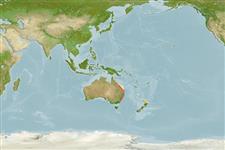Environment: milieu / climate zone / depth range / distribution range
Ecologie
marien; brak water demersaal; diepte 0 - 30 m (Ref. 6390). Subtropical; 17°S - 38°S
Western Pacific: endemic to Australia. Present along the east coast between approximately Cairns, Queensland (Ref.27242) and Gippsland lakes in eastern Victoria.
Lengte bij maturiteit / Grootte / Gewicht / Leeftijd
Maturity: Lm 50.2 range ? - ? cm
Max length : 120 cm TL mannelijk / geslacht onbekend; (Ref. 27112); max. gepubliceerd gewicht: 15.0 kg (Ref. 27248)
Korte beschrijving
Determinatiesleutels | Morfologie | Morfometrie
Dorsale stekels (totaal) : 8 - 9; Dorsale zachte stralen (totaal) : 13 - 14; Anale stekels: 0; Anale zachte stralen: 13 - 14; Wervels: 27.
Generally inhabit shallow bays and inlets and can be found in estuaries as far as tidal limits (Ref. 27246); they often invade freshwater. They occur over mud, silt gravel, sand and seagrass (mainly Zostera species) beds from intertidal areas to depths of 10 m in Queensland and to 30 m in southern New South Wales. Eggs and larvae are dispersed along the coast by tidal and current movements (Ref. 27112). Small juveniles less than 12 cm TL first appear in coastal bays 1-2 months after spawning. They mainly inhabit shallow mangrove and mud flats and seagrass beds (Ref. 27246, 27245). They are usually solitary but may form loose aggregations (Ref. 2165, 27247). Feed on small fish, crabs, prawns, small crustaceans. octopus, squid and polychaete worms. They have spines on the outer edges of their head which can inflict nasty cuts during handling (pers. comm., Bernard Moss, 2001).
There is conflicting information (Ref. 27246, 27245, 27247) on whether dusky flahead are protandrous sex reversers or not.
Paxton, J.R., D.F. Hoese, G.R. Allen and J.E. Hanley, 1989. Pisces. Petromyzontidae to Carangidae. Zoological Catalogue of Australia, Vol. 7. Australian Government Publishing Service, Canberra, 665 p. (Ref. 7300)
Status op de Rode Lijst van het IUCN (Ref. 130435: Version 2024-1)
Gevaar voor de mens
Harmless
Gebruik door de mens
Visserij: commercieel; sportvis: ja
Tools
Speciale rapporten
Download XML
Internetbronnen
Estimates based on models
Preferred temperature (Ref.
123201): 19.1 - 27.1, mean 25.2 °C (based on 291 cells).
Fylogenetische diversiteitsindex (Ref.
82804): PD
50 = 0.5000 [Uniqueness, from 0.5 = low to 2.0 = high].
Bayesian length-weight: a=0.00457 (0.00230 - 0.00908), b=3.09 (2.91 - 3.27), in cm total length, based on LWR estimates for this (Sub)family-body shape (Ref.
93245).
Trofisch niveau (Ref.
69278): 4.1 ±0.52 se; based on food items.
Weerstandsvermogen (Ref.
120179): Gemiddeld, minimale populatieverdubbelingstijd 1,4-4,4 jaar (K=0.22; tm=2).
Fishing Vulnerability (Ref.
59153): High to very high vulnerability (72 of 100).
Nutrients (Ref.
124155): Calcium = 132 [8, 523] mg/100g; Iron = 2.27 [0.58, 6.12] mg/100g; Protein = 19.2 [16.9, 21.6] %; Omega3 = 0.481 [0.216, 1.350] g/100g; Selenium = 54.4 [13.6, 213.1] μg/100g; VitaminA = 4.35 [1.42, 12.68] μg/100g; Zinc = 0.72 [0.34, 1.57] mg/100g (wet weight);
